Naval artillery
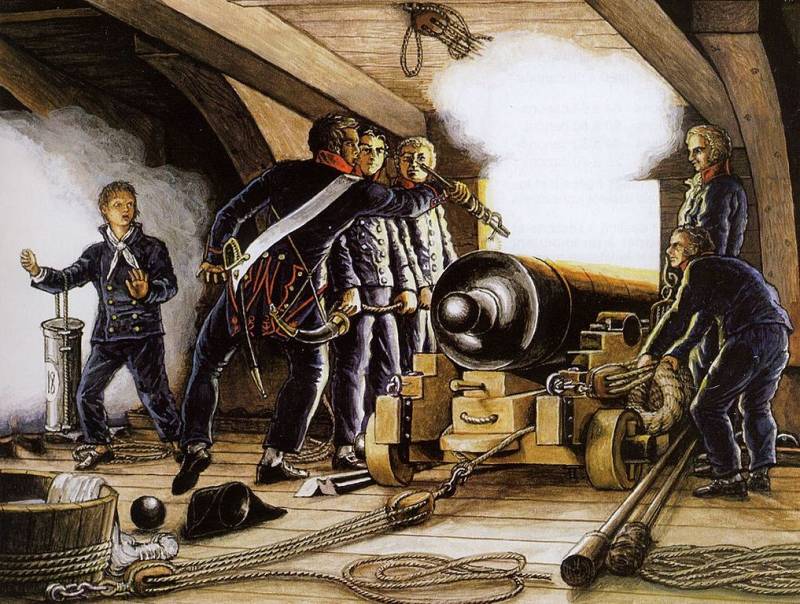
Several recent articles have shown that we need to seriously talk about naval artillery, its features, applications and problems that arose. That is, we will briefly try to determine what the artillery of the era of sail is in general, and what it is eaten with.
Before the invention of guns
Perhaps the first prototype of naval artillery was invented and implemented by Gaius Julius Caesar (here we rely on the “Comments on the Gali War”), who ordered the installation of catapults on ships. Previously the favorite tactic fleet In antiquity there was ramming and boarding.
It is clear that firing at ships from catapults firing along a hinged trajectory did not make much sense, because hitting a “ship” type target was possible only by a miracle. Such proto-artillery was used well in an attack against the coast.
The next step was taken by the Byzantines, who invented Greek fire and flamethrowers. It was already quite weapon close combat, which could be used against other ships.
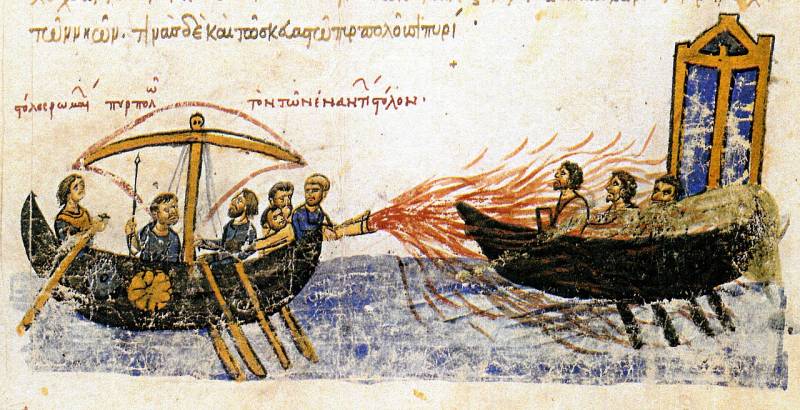
Using Greek fire.
But the Chinese came closest to creating artillery in the form in which we imagine it.
In 1293, the Emperor of China, Kublai Khan, during his invasion of Java, among other things, used barrels made of bamboo installed on ships, which fired spears or bullets (a prototype of grapeshot), throwing them out with the help of the combustion energy of black powder. These guns were appreciated throughout Southeast Asia, because from 1300, guns of this type (ketbangs) spread throughout the region.
Finally, by 1330–1350, both Europe and Asia almost simultaneously came to the invention of conventional cannons. The first recorded naval battle where cannon was used was the Hundred Years' War, the Battle of Arnhemdein (23 September 1338).
The fact is that in this battle there was one ship (English Christopher), who was armed with three cannons and one handgun. It is noteworthy that the firearm did not turn out to be a superweapon; the British lost that battle, and he himself, armed with guns, Christopher The French captured it by good old boarding.
Trial and error period
In the XNUMXth century, cannons became mandatory on almost all ships.
There was only one thing that stopped it - before the invention of the gun carriage and its attachment to the side, the recoil from the shot was great, and the braking distance of the gun exceeded the width of the ship. Therefore, guns at that time were placed either at the bow or at the stern. One or two cannons in the center were large-caliber cannons - “basilisks”; one or two smaller guns were placed nearby - serpents, sacrs and falcones. Then the question of at least some standardization arose.
Since the artillery systems were completely raw, one gun could differ from another, both in length and in the internal diameter of the barrel, the intuitive solution came to divide the guns according to the weight of the projectile. Thus, the basilisks became 50- or 60-pound cannons, the serpents or culverins - 17-20 pounds, the sacra - 8-9 pounds, the falcones - 4- or 6-pounders.
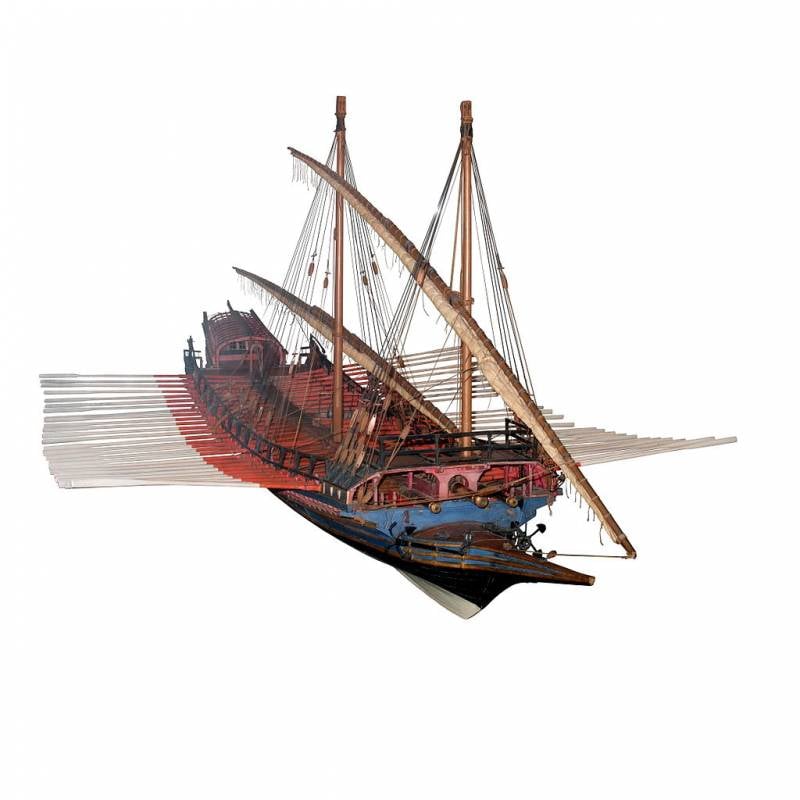
Armament of a French galley of 1736.
The problem was that the pound was not the same in different countries, and this created certain problems. For example, in England the pound was equal to 0,453 kg, but in France it was already 0,4895 kg, in Spain - 0,4608 kg, in Russia the artillery pound was 0,4914 kg (established personally by Peter I in 1700), in Netherlands - 0,4941 kg, etc.
That is, in all countries, despite seemingly approximately the same caliber scale (and then caliber meant either the weight of the cannonball or the length of the barrel, and not the internal diameter, as we are used to), the dimensions of the barrel and the diameter of the guns were different. For example, a gun with a length of 20 calibers was a gun with a barrel length of 20 diameters of its core.
Finally, in 1712, the Danish Colonel Albrecht Borgard, invited to England as an expert, introduced the standardization of ship armament values. The data is summarized in a table.
In 1702, English artillery was standardized and took the form shown in the table:

Well, guns have a lower projectile mass.
By length, the guns were divided into long (length from 20 calibers), short from 9 to 15 calibers, and howitzers (which included mortars), up to 6 calibers. This system was entrenched in the English fleet right up to the XNUMXth century.
As for the French and Spanish fleets, after 1714 they carried guns with cannon ball weights of 36, 24, 18, 12, 8 and 6 pounds. Due to the greater value of the pound, the French 36-pound core was equivalent to the British 39 pounds. But the heavier gun also loaded more slowly, so the British 32-pounder had an advantage over the French 36-pounder in loading speed.
The fastest-firing of the heavy ones turned out to be 24-pound cannons, which the Dutch loved very much; in the battle of Dogger Bank (1781) they managed to fire one shot every 55 seconds. For comparison: well-trained English teams fired two shots every three minutes from 32-pounders; the rate of fire of French 36-pounders was one shot every three minutes.
Cannon production
Initially, guns were produced in the following way: several strips of iron were cast, which were connected to each other by forging around a wooden core and reinforced with connecting rings. It is clear that such a gun was largely defective, threatened to burst along any seam, and had low accuracy and reliability.
That is why, around the 1560s, guns began to be cast as a single unit, and a special blank, a core, was inserted into the molten metal in the center, which formed the bore. Next, the gun cooled down, the blank was removed or crumbled, and after processing the gun was ready for use.
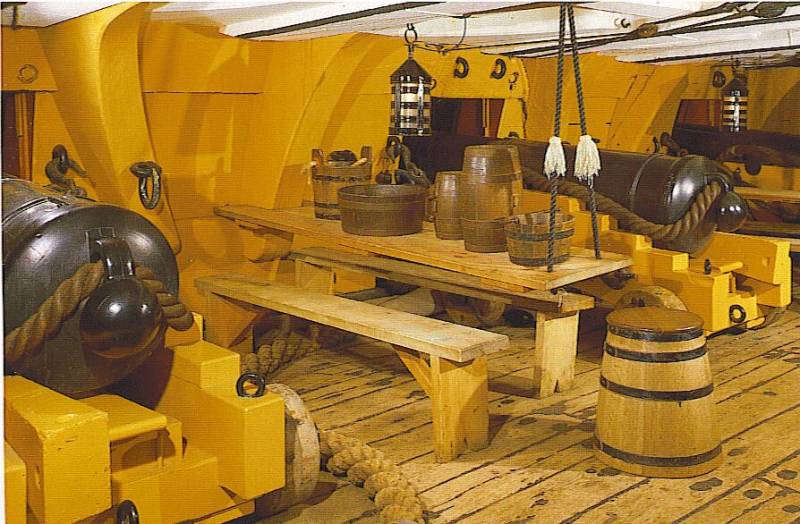
32 lb lower deck battery on the English battleship Victory.
It would seem simple? No, it's not easy.
Because of this casting, some of the guns were of poor quality - the cast iron cools unevenly, and due to the temperature difference between the core and the cast iron barrel, shells were formed inside the channel, which led to ruptures of the guns during firing.
In 1729, the Swede Moritz proposed a new technology - the cannons were cast in one piece from gray cast iron, and then the barrel was drilled out. A machine for drilling trunks was demonstrated for the first time in Lyon, France in 1734. And starting from the 1740s, guns began to be manufactured using this technology.
However, until the 1760s it was not possible to drill the trunk strictly horizontally. Most often, the barrel cone went at a slight angle to the side, and as a result, the wall thickness was uneven. Which again led to increased wear and, as a consequence, to rupture of the guns.
Because of these problems with the manufacture of iron cannons, large caliber bronze artillery finally disappeared from the scene only in the 1780s. But even in 1812, some ships still had light 12-, 9-, 6- and 3-pounder guns. Also, until the end of the Age of Sail, bronze was used to make land mortars and howitzers; on ships, these types of guns were mainly cast iron.
Guns in battle
How many people does it take to operate one cannon?
This is not an idle question. After all, the same 32-pound gun weighs 3,85 tons.
Initially, gun crews were divided into “fours”. This was very convenient, since initially different types of guns were serviced by calculations that were multiples of four. A little later (in the 1720s) this rule ceased to apply; 32-pound guns were served by a crew of 14 people, 24-pound guns by 12 people, 18-pound guns by 11 people. 12-pound - from 8 people, 9- or 8-pound - from 6 people, respectively.

Firing from an 18-pounder French cannon. Apparently, the battle is fought on two sides, since in the normal version the cannon should be serviced by 11 people.
Let's take the crew of a 32-pound gun. It consisted of 1 gunner, 1 assistant gunner, two people supplying charges and cannonballs, and... that’s it. The remaining 10 people were divided into fives and either pulled the cannon to the port or rolled it inward.
Yes, one calculation related to two guns - the left and right sides, respectively. But most battles were fought by ships with only one side, because being hit by two fires sharply reduced the intensity of fire and actually meant a complete loss of the battle.
In combat instructions (Articles of War) on the English fleet (1745), article XXXV reported the following: “The captain of a ship is obliged to maintain discipline on the ship entrusted to him and often conduct exercises of artillery teams with great guns and small arms (to render them more expert in time of battle), and also record in ship's log the time of these exercises".
However, the law is one thing, and its execution is another. Everything depended on the specific captain. For example, on Nelson's Victory, exercises were held... once a week.
In general, at Trafalgar, approximately half of Nelson's squadron had poor artillery training and had last conducted gunnery training three or more months ago.
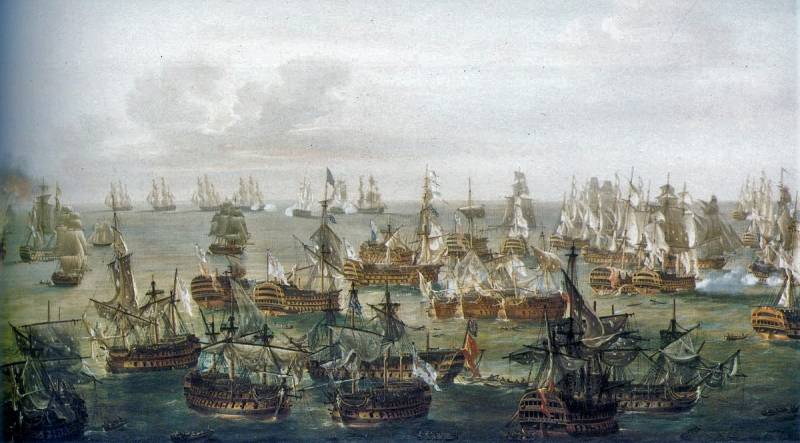
Battle of Trafalgar, 1805.
And that was not the whole problem. Here, for example, is what midshipman William Pringle Green wrote from Conqueror:
As a result, during the battle, a not very pleasant feature was revealed: those guns with which they trained were cleaned, scrubbed, ready for battle, and fired perfectly. On the remaining guns, malfunctions were often observed, for example, rust in the barrel, or a damaged carriage, or weakened and frayed ropes. In battle, these guns often self-exploded, bounced to the side, fell off their carriages, and came off their mounts.
Separately, it is worth mentioning the tools that are used to care for guns. Sponges that were not used for a long period often simply crumbled, the banners suddenly turned out to be bald or broken, but if you add in the fuss during battle, manipulation of ammunition, etc., it is clear that such consequences should not seem extraordinary.”
Carronades
To reduce the weight of the gun and the number of personnel servicing it, the English Navy came up with an unusual option. This is a large caliber gun, but short and thin-walled. Such guns could fire not far away, but with large-caliber cannonballs. Moreover, at close range, these cannonballs did not pierce, but broke through the side of the enemy ship, forming a pile of wood chips.
It must be said that the topic was not new for the British - they tried to use lightweight “drake” cannons back during the Anglo-Dutch wars, but by the ordinance of 1712 they were removed from the fleet.
So, in the 1780s it was proposed to replace the cannons on the upper deck with carroanades. At that time, the British had mostly 9- or 6-pound long guns on their superstructures and quarterdecks, weighing either 1,585 tons or 1,068 tons, respectively. If such a cannon is replaced with a 32-pound carronade (which weighs only 784 kg), then the weight of the salvo at close range will increase multiple times, in addition, due to the special design of the sliding carriage, the carronade could be serviced by only two people.
Thus, the British received an excellent close-combat weapon.
It must be said that the innovation did not pass by the French and Spaniards. So, in 1784, the Spaniards purchased from England two 96-pound carronades, two 68-pounders and two 42-pounders, as well as 50 cannonballs for each cannon. These carronades were supposed to be compared with 36-, 24- and 18-pounder guns. 30 shots were fired from each carronade; engineer Rovira was in charge of the tests.
Actually, this was the main problem, because Rovira was not a sailor. The engineer noted that long guns provide a much greater firing range than carronades, and also have a much smaller penetrating effect on the target body, which is especially noticeable at distances over 150 yards.
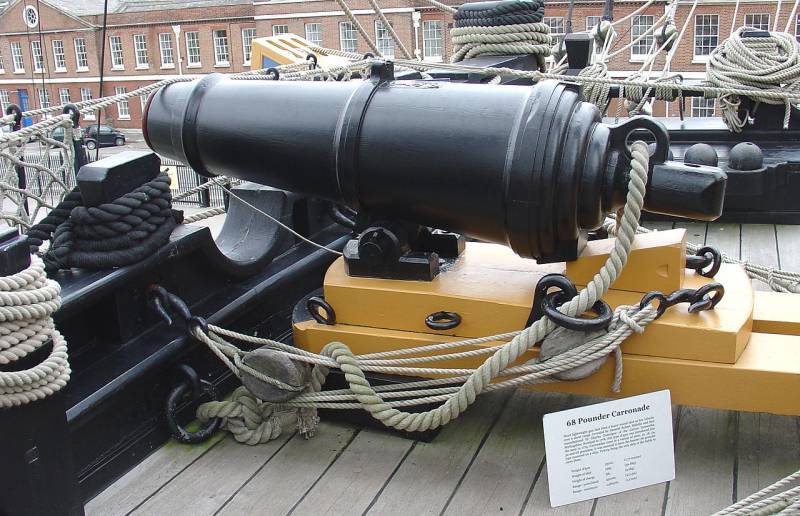
68 pound carronade on the forecastle of the battleship Victory.
Since the engineer was not a sailor, he did not know that in a naval battle the cannonball from the carronade formed a pile of wood chips directed into the ship, and it was this wood chips that mostly killed and maimed the crews.
Lieutenant General Langara, who favored the adoption of these new weapons, was surprised by their speed of loading and rate of fire. He estimated that the 96-pound carronade fired one shot in one minute 40 seconds, the 68-pounder fired in one minute 34 seconds, and the 42-pounder reloaded in just 45 seconds.
However, after the tests, the Spaniards... safely handed over the carronades to warehouses and forgot about them. We had to remember the carronades in 1805, at Trafalgar, when the British and their carronades, like machine guns, simply mowed down the crews of French and Spanish ships. Before the battle, Villeneuve and Gravina hoped for a scrap and the good old boarding due to the increased landing teams, but it was the carronades that drowned in blood all boarding attempts by the French and Spaniards.
References:
1. Chuck Meide “The Development and Design of Bronze Ordnance, Sixteenth through Nineteenth Centuries” – The College of William & Mary, 2002.
2. NAM Rodger “The Wooden World: An Anatomy of the Georgian Navy” – New-York-London, “WW Norton & Co”, reprint, 1996.
3. Spencer C. Tucker “Naval Warfire” – “Sutton Publishing”, Phoenix, 2000.
4. Enrique García-Torralba Pérez “La artillería española en el siglo XVIII” – Ministerio de Defensa, 2010.
5. Jean Boudriot, “L'artillerie de mer: marine française 1650–1850” – Paris, Ancre, coll. "Archéologie navale française", 1992.
6. NAM Rodger “Image and Reality in Eighteenth-Century Naval Tactics” – Mariner's Mirror 89, No. 3 (2003), pp. 281–96.
Information